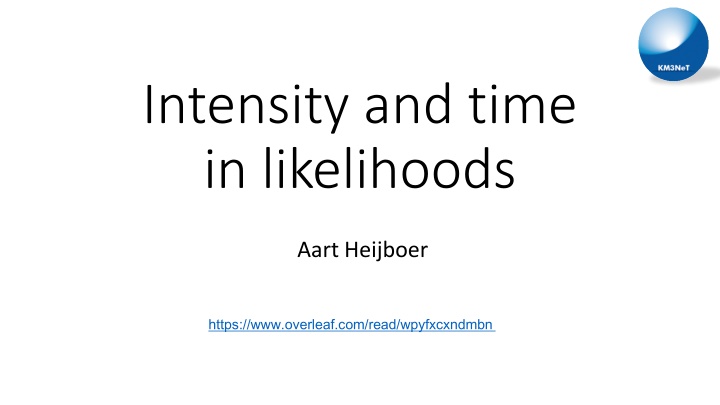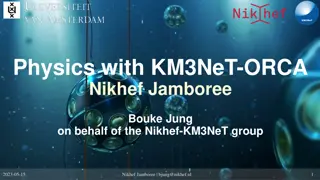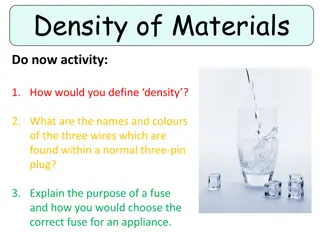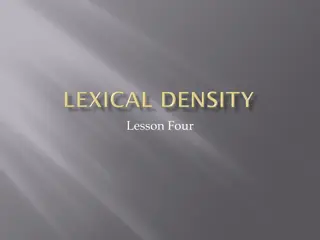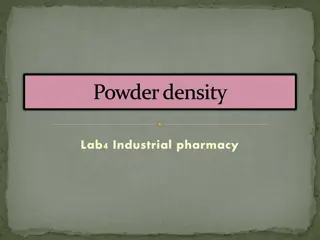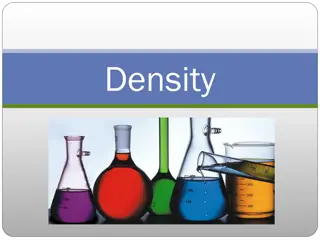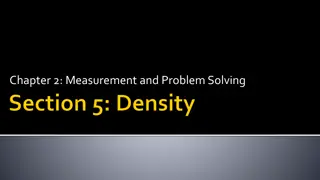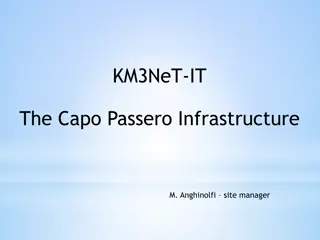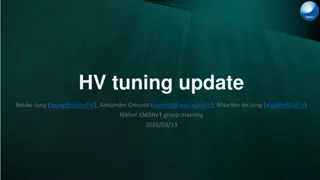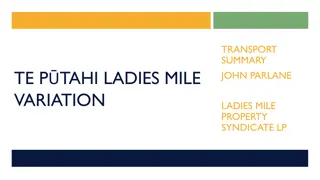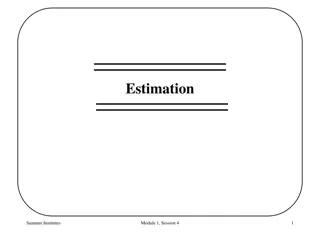Analysis of Photon Density and Likelihood in KM3NeT Logo Web
This content delves into the intensity and time in likelihoods related to photon density in the KM3NeT logo web images. It discusses the density of photons, hit probabilities, time of first photon, and delineates the full likelihood of first-hit times. The analysis includes discussions on signals, background rates, first-hit times, and the concept of hit versus no-hit scenarios. Various aspects of photon density and likelihoods are explored in the context of the KM3NeT logo web images.
Download Presentation

Please find below an Image/Link to download the presentation.
The content on the website is provided AS IS for your information and personal use only. It may not be sold, licensed, or shared on other websites without obtaining consent from the author.If you encounter any issues during the download, it is possible that the publisher has removed the file from their server.
You are allowed to download the files provided on this website for personal or commercial use, subject to the condition that they are used lawfully. All files are the property of their respective owners.
The content on the website is provided AS IS for your information and personal use only. It may not be sold, licensed, or shared on other websites without obtaining consent from the author.
E N D
Presentation Transcript
http://www.km3net.org/logo/oldLogo/KM3NeT_logo_web_no_shade.gifhttp://www.km3net.org/logo/oldLogo/KM3NeT_logo_web_no_shade.gif Intensity and time in likelihoods Aart Heijboer https://www.overleaf.com/read/wpyfxcxndmbn
http://www.km3net.org/logo/oldLogo/KM3NeT_logo_web_no_shade.gifhttp://www.km3net.org/logo/oldLogo/KM3NeT_logo_web_no_shade.gif Density of photons (or pe or hit) at time t (not a PDF) Number of photons detected before t (not a probability) n(t) (ns-1)
http://www.km3net.org/logo/oldLogo/KM3NeT_logo_web_no_shade.gifhttp://www.km3net.org/logo/oldLogo/KM3NeT_logo_web_no_shade.gif Reminder : the hit/nohit likelihood as used in aashowerfit For energy- and direction reconstruction 3
http://www.km3net.org/logo/oldLogo/KM3NeT_logo_web_no_shade.gifhttp://www.km3net.org/logo/oldLogo/KM3NeT_logo_web_no_shade.gif Interested in time of first photon, because that is what we have in data. Density of first photons (not a PDF) P(zero hits before t) Probability to have at least one photon before t. ( <1 ) The PDF of the first Hit-time t1 P(at least one hit ever) For the connoisseurs: works for any n(t1), no time-window needed in contrast to p(t) 4
http://www.km3net.org/logo/oldLogo/KM3NeT_logo_web_no_shade.gifhttp://www.km3net.org/logo/oldLogo/KM3NeT_logo_web_no_shade.gif If we have (constant) background: This is 1, thanks to the background Okay, so let s write down the full likelihood of all the first-hit-times . Subscript s : signal R : background rate 5
http://www.km3net.org/logo/oldLogo/KM3NeT_logo_web_no_shade.gifhttp://www.km3net.org/logo/oldLogo/KM3NeT_logo_web_no_shade.gif Okay, so let s write down the full likelihood of all the first-hit-times . M: number of PMTs [time-1] [time-1] [dimensionless] ti : first hit time om PMTi The functions n and N formally also need an index i (they differ per PMT) 6
http://www.km3net.org/logo/oldLogo/KM3NeT_logo_web_no_shade.gifhttp://www.km3net.org/logo/oldLogo/KM3NeT_logo_web_no_shade.gif hit no hit n(t) signal Define a tc so that all the signal photons are guaranteed to happen before tc background tc t zero constant Nstot constant 7
http://www.km3net.org/logo/oldLogo/KM3NeT_logo_web_no_shade.gifhttp://www.km3net.org/logo/oldLogo/KM3NeT_logo_web_no_shade.gif * Does not look like the hit-PMT term from the hit/nohit likelihood. Instead, it almost looks like the PDF of the first hit-time just need the normalization. Exactly the empty-PMT Term from the hit/nohit Likelihood. Does not depend on ti! The PDF of t, p(t) With Ntot all (s+b) hits expected before tc 8 *probably this the simplest expression for the likelihood if we don t care about splitting it up for educational purposes.
http://www.km3net.org/logo/oldLogo/KM3NeT_logo_web_no_shade.gifhttp://www.km3net.org/logo/oldLogo/KM3NeT_logo_web_no_shade.gif So, finally: log(pdf(first-hit-time)) The hit-PMT term from the hit/nohit PDF! Calling PMT with t > tc unhit : 9
http://www.km3net.org/logo/oldLogo/KM3NeT_logo_web_no_shade.gifhttp://www.km3net.org/logo/oldLogo/KM3NeT_logo_web_no_shade.gif What have we learned? - - - Rigorous way to talk about and combine different aspects of the data. Evaluate information in each term. In the end: the first hit times contain all the information (because if you have a hit time, you know you have at least one hit). In the end, it s all obvious - Statistical data analysis exam question
http://www.km3net.org/logo/oldLogo/KM3NeT_logo_web_no_shade.gifhttp://www.km3net.org/logo/oldLogo/KM3NeT_logo_web_no_shade.gif Combine hit/nohit with time?
http://www.km3net.org/logo/oldLogo/KM3NeT_logo_web_no_shade.gifhttp://www.km3net.org/logo/oldLogo/KM3NeT_logo_web_no_shade.gif Combine hit/nohit with time? Problem: write down likelihood that is correct start from first-hit time pdf, separate in signal-window and very-late hits Existing aashowerfit pdf Pdf of first hit time We can add these likelihoods! Analyze information in each term in coherent way prospect of using one likelihood for all event signatures.
http://www.km3net.org/logo/oldLogo/KM3NeT_logo_web_no_shade.gifhttp://www.km3net.org/logo/oldLogo/KM3NeT_logo_web_no_shade.gif Information Hit presence does noting for position Energy dominated by hit presence Direction : both, but time dominates (!) E = 105, point-like shower 13
http://www.km3net.org/logo/oldLogo/KM3NeT_logo_web_no_shade.gifhttp://www.km3net.org/logo/oldLogo/KM3NeT_logo_web_no_shade.gif Information Adding timing has potential for the direction! - (Jordan is on the case) - Peaks and valleys stemming from JPP Pdfs. - Reviving photon tracking Hit presence does noting for position Energy dominated by hit presence Direction : both, but time dominates (!) E = 105, point-like shower 14
